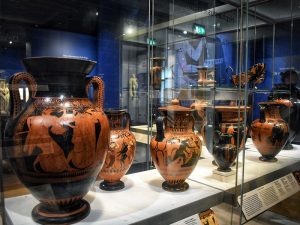Antichità Roma represent an intriguing aspect of our shared cultural heritage, spanning the history of religions and nations. Their unique characteristics create distinct valuation and market dynamics that require specialized analysis and expertise.

When buying antiques look for reputable dealers that belong to trade associations as these will be able to assist with mediation and resolution if anything goes wrong. Also, consider that antiques might change in appearance over time.
Unlike art or furniture, where beauty and function are the main drivers of value, an antiquity’s worth is intrinsically linked to its authenticity. Buyers will not pay a premium for an item that is not as ancient as advertised, and the archaeological evidence that validates its age can be a deal-breaker.
Despite the fact that the modern illicit trade in antiquities is a multibillion dollar industry, with criminal activity occurring at all levels of the supply chain, legal penalties for theft and trafficking are rarely effective deterrents for looters and dealers. Photographic archives of artefacts being removed from the field or of fragments in transit seem to be far more effective at disrupting this criminal enterprise as they can prove that a given object is illicit, and therefore its authenticity.
Most ‘source countries’ claim ownership of all artefacts found on their national territory, and removing these objects without a permit is illegal. But even where this is the case, it is not possible to obtain detailed archaeological provenance for every single object on sale in the market. This means that for the majority of antiquities there is little, if any, authentic archaeological context.
As such, it is vital that buyers always seek out a reputable dealer who can vouch for the authenticity of an antiquity they are interested in purchasing. This is one of the main reasons why many museums, galleries and auction houses have in-house antiquities specialists, who can confirm the legitimacy of a piece before it goes on the sale floor.
Aside from this, there are a number of other techniques that can be used to verify an antiquity’s authenticity. These can include chemical analysis of the paint and other materials, examining the freshness of tool marks or assessing the concentration of mineral inclusions within metal. However, these techniques have their limitations and fakers can often get around them. Nevertheless, these methods can be very helpful for buyers seeking to ensure that they are getting what they pay for. As a result, they are highly recommended for those looking to invest in an antiquity.
Provenance
Provenance refers to the historical record of ownership and transference of art objects, including information about where it has been displayed or sold. It is a critical component of due diligence and verification when purchasing antiquities. Ideally, provenance includes documentation of the name and date of each owner; the methods of transference, such as inheritance or sale through a dealer; and the locations where the work has been kept, from its time of creation by an artist to its present location.
Early collectors and institutions began to document the histories of their collections in order to increase the credibility and value of the pieces they owned. This practice became known as “provenance.” Today, antiques with documented histories are viewed as more valuable by both dealers and buyers because they offer a verifiable history of authenticity.
Moreover, provenance research is increasingly being viewed as an important way to combat the illicit trafficking in cultural heritage. The global trade in looted and stolen antiquities fuels criminal activity such as terrorist financing, money laundering, and organized crime, creating a direct threat to national security. As a result, museums and other purchasers are increasingly requiring thorough provenance research before acquiring works of art.
Unfortunately, the focus on ensuring that antiquities enter the market through legal channels is difficult to achieve because many source countries are plagued by considerable political instability. This makes widespread looting a nearly impossible problem to curtail.
In addition, the trade in antiquities is a centuries-long tradition that transcends institutional boundaries. This means that while museums have numerous policy reasons for adopting a threshold below which they will not acquire works without provenance, the vast majority of collectors will not share this cut-off point.
Despite the importance of provenance, it is important to recognize that even the most complete records will not ensure the full truth. For example, there is still some doubt about the authenticity of two Nok terracotta figures and an ekpu figure that originated in Nigeria and were part of the collection of the Museum of Fine Arts, Boston, as late as 1976. These items have since been reclaimed by the Nigerian government as evidence of illegal export and trafficking.
Legality
In addition to the various conventions, legal procedures and rules that are in place to help stifle illicit antiquities trade, dealers themselves need to exercise their own due diligence. This means checking an antiquity’s documentation, its physical appearance and its provenance. Using an antiquity dealer who is a member of the International Association of Dealers in Ancient Art (IADAA) or other recognised trade body that has a rigorous Code of Conduct, will provide peace of mind.
Some antiquities are illegally removed from archaeological sites by people who do not have the correct permits or knowledge of how to excavate properly. This is very harmful to the sites as well as to the individual artifacts, since it can destroy them. The destruction of archaeological objects destroys valuable information about the past that could be used to understand, preserve and learn from the archaeological heritage. The removal of such items also causes damage to the structures, surfaces and deposits where they have been taken.
Unfortunately, the black market antiquities trade is a huge and complex problem. It is not stifled by the various laws and conventions that exist, as it is very lucrative for criminals and gangsters who are involved in it. Many of the funds from the sale of these antiquities are smuggled back into the source countries and invested in other unpleasant activities, including exploitation, coercion and even murder.
Cultural property agreements are an effective tool to reduce the pillage of archaeological and ethnological materials. They can be negotiated by the Department of State’s Cultural Heritage Center as a bilateral memorandum of understanding and require that the objects be returned to the country of origin upon leaving the United States. They also increase responsible cultural exchange by establishing a framework for collaboration between museums, heritage institutions and government agencies.
In addition to establishing protocols for responsible cultural exchange, these agreements can also open doors to increased financial and practical assistance from the United States for archaeological site conservation, capacity-building training for museum and heritage professionals, and research on cultural property issues. They also help to strengthen relationships between the United States and other nations in fields related to heritage, law enforcement, museum collection care and security, and trading and export control.
Care
An antique’s value and beauty depend on the preservation of its original condition. Proper handling and cleaning techniques can help ensure the longevity of an item and preserve its integrity. Antiques should be handled gently and with gloves, as the natural oils in the skin can damage materials. Handle pieces of wood by their strongest parts, for example the base or arms, and avoid dragging furniture as this can put undue strain on joints.
The most common causes of damage are temperature fluctuations, humidity changes, strong light (especially sunlight), chemical exposure, and physical stress. Ideally, antiques should be stored in stable and benevolent environments away from these factors, such as in a cool and dark room with a low humidity. A digital hygrometer and thermometer can be useful tools in ensuring the conditions of your collection are optimal.
Antiques often develop surface damage over time, such as dents or scratches. While minor marks may add to the character of a piece, it is important to repair significant damage promptly to prevent further deterioration. This can be done by patching and re-gluing joints or filling and sanding surfaces. It is crucial that any repairs or refinishing are made by a qualified conservator to reduce the risk of irreversible damage.
Never spray an antique with a furniture polish or duster, as these products can contain silicones that are difficult to remove. It is recommended to use a cloth lightly dampened with white spirit or linseed oil instead. Always test a cleaning fluid on a small area of the object before applying it to the whole surface.
It is also recommended that you keep detailed records of all antiques in your collection and their current value, as this will be helpful if the item is damaged or lost. Finally, it is a good idea to consult a reputable insurance provider to ensure your antiquities are covered against accidental damage and theft. This is especially important for expensive and valuable items.


